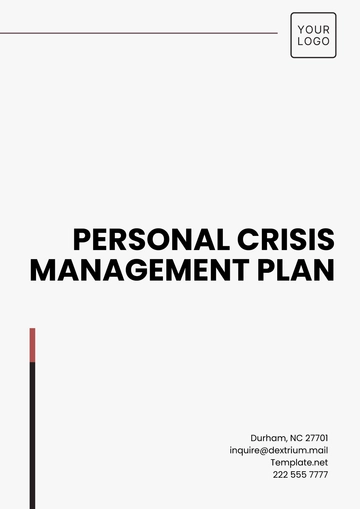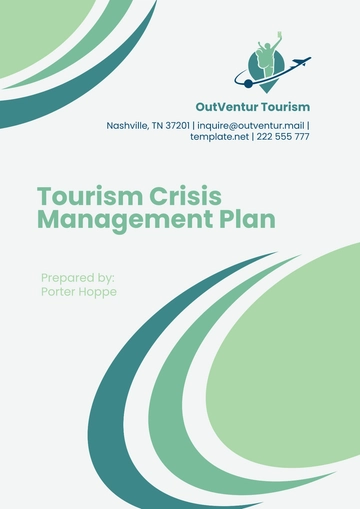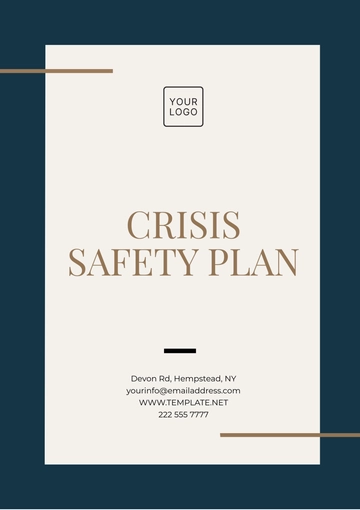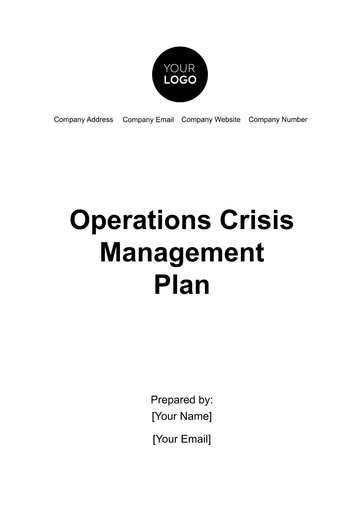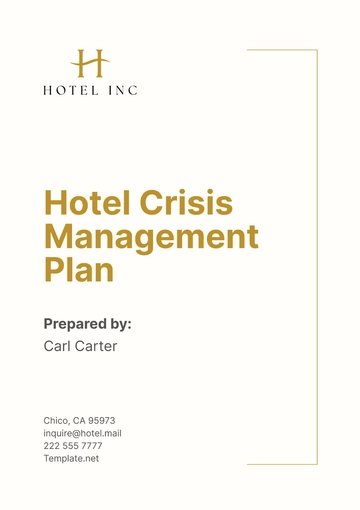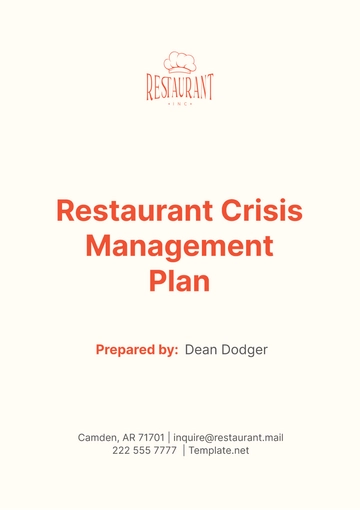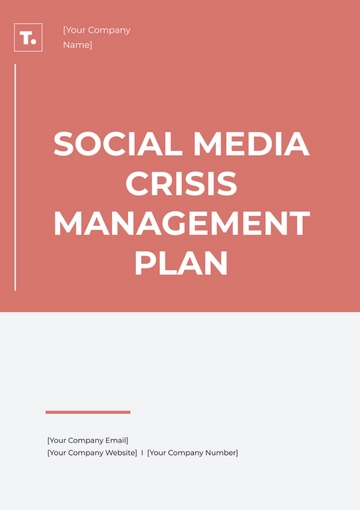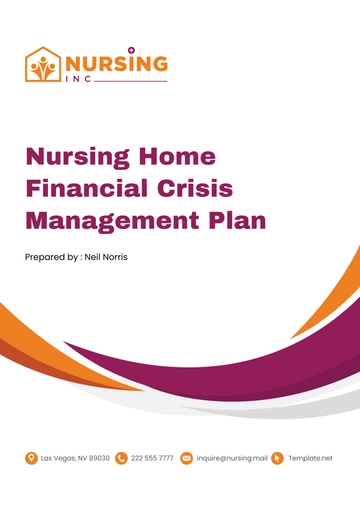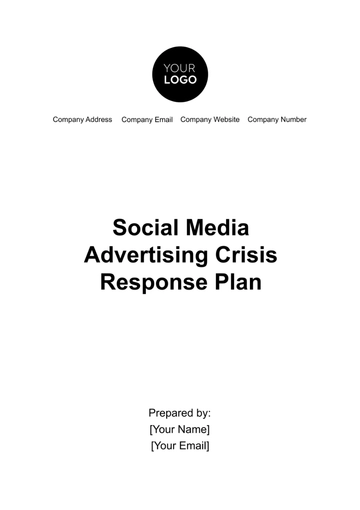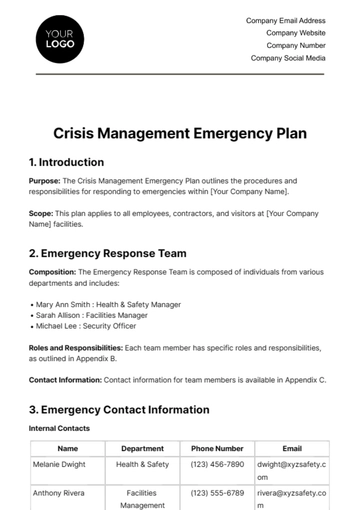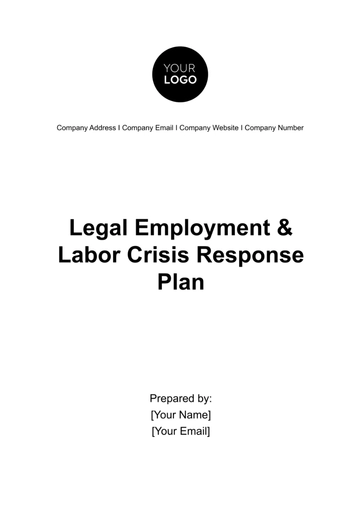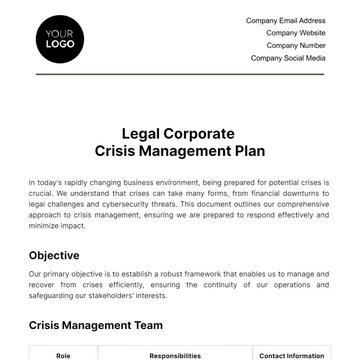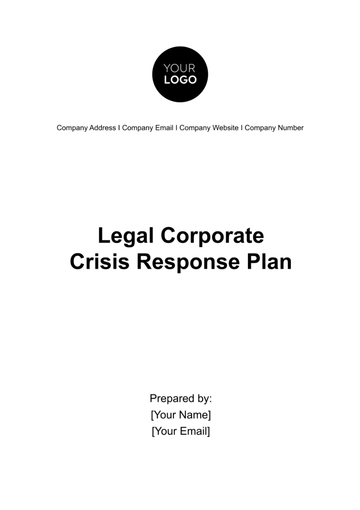Free Legal Employment & Labor Crisis Response Plan
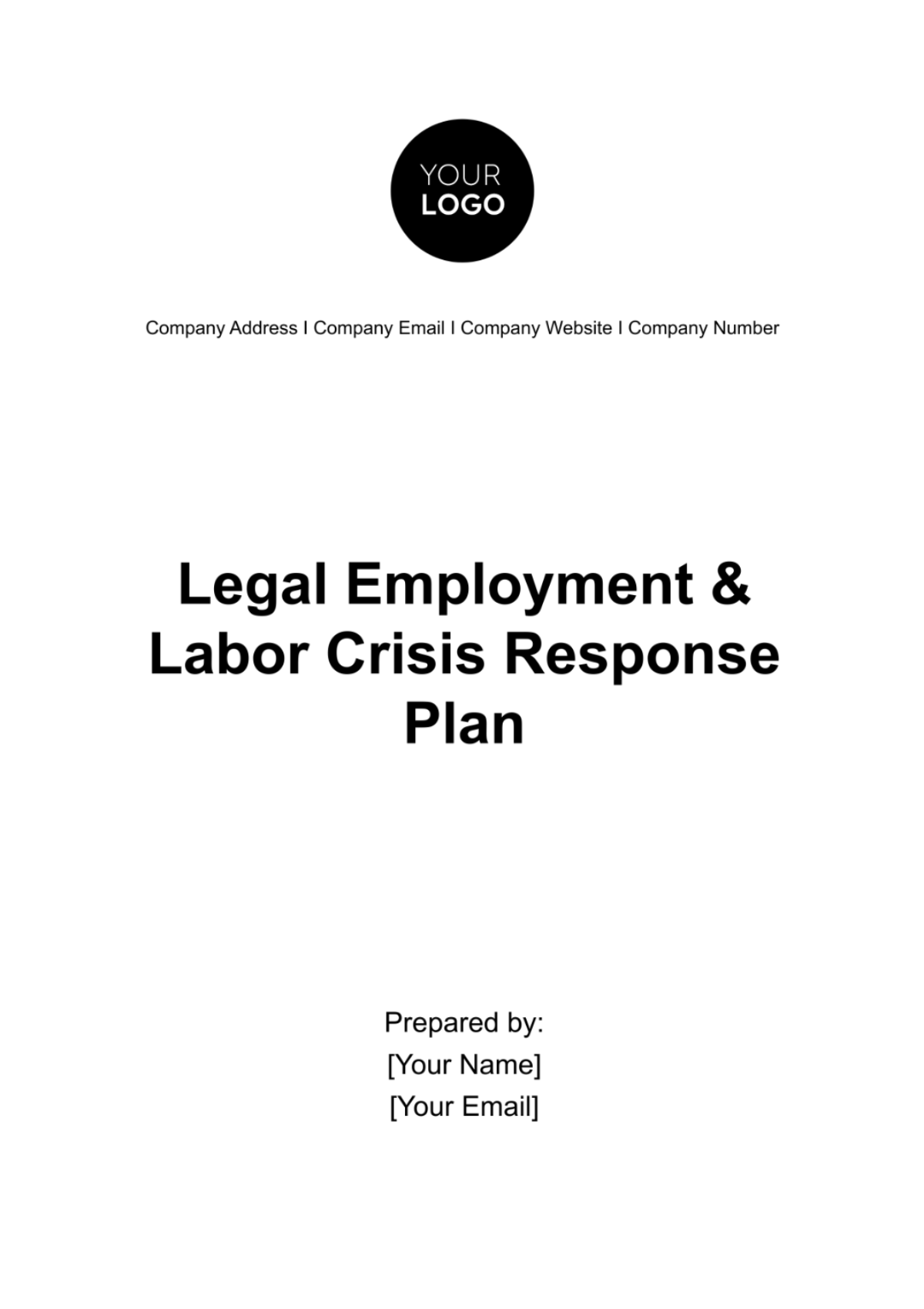
I. Introduction
In response to the dynamic nature of modern workplaces and potential legal challenges, the organization has developed this comprehensive Legal Employment & Labor Crisis Response Plan. This plan serves as a proactive measure to safeguard the interests of the organization, its employees, and stakeholders during times of crisis. By outlining clear protocols and procedures, the plan aims to ensure swift and effective responses to legal issues related to employment and labor, thereby minimizing disruptions and mitigating potential liabilities. Additionally, the plan underscores the organization's commitment to upholding legal compliance, fostering a supportive work environment, and preserving business continuity in the face of adversity.
II. Executive Summary
The Legal Employment and Labor Crisis Response Plan is a strategic document that has been carefully designed to offer a succinct summary of the important elements of managing legal challenges in the context of a crisis. It encapsulates key components, objectives and identifies the stakeholders that play a critical role during a crisis. Moreover, the crisis response plan serves a critical function as a roadmap that helps guide the decision-making processes of the organization, facilitates smooth communication across various divisions, and stipulates the appropriate actions to be taken by leadership and operational teams.
To further augment the effectiveness of the crisis response plan, the structure and priorities of the plan have been meticulously outlined in an executive summary, a tool that aims to foster a shared comprehension among all stakeholders. The main objective of the executive summary is to ensure that all relevant parties are not only aligned in their comprehension of the crisis response plan but also are able to respond in a coordinated and effective manner to legal issues as and when they arise. The executive summary also places a strong emphasis on the critical imperative of engaging in proactive planning procedures and continuously improving the organization's crisis management strategies. Such an approach is pivotal in augmenting the resilience of the organization and guaranteeing that it is adequately prepared to manage future crisis scenarios. Hence, both the Legal Employment and Labor Crisis Response Plan and the related executive summary play an instrumental role in equipping the organization with the necessary tools and resources to navigate legal challenges during crises effectively and efficiently.
III. Risk Assessment and Identification
It is crucial to undertake an exhaustive risk assessment procedure for the identification and comprehension of potential risks and vulnerabilities tied to employment and labor during tumultuous times. This imperative process involves meticulously studying past data, obligatory regulatory requirements, ever-changing industry trends, and the organization's internal practices to foresee potential hurdles that may arise in the course of business operations. Identification of the spearheading risk factors is a pivotal action that enables the organization to allocate resources efficiently and effectively. Not only does this enable the strategic positioning of resources, but it also allows for the careful implementation of preventive measures which are set in place to ward off possible debilitating effects on the organization's operations. Furthermore, the organization is able to devise and develop contingency plans, which work to reduce the impact of crises in a substantial manner.
Adding to these strategies, it is also of the utmost importance to continually review and update the risk assessment process to verify that the organization remains alert and quick to respond to any shifts in the legal requirements that must be adhered to, as well as corresponding operational landscapes. By doing so, the organization can ensure that it always has a grasp on any possible changes and can swiftly adapt to any alterations in order to maintain the smooth running of its operations.
IV. Crisis Management Team
The Crisis Management Team (CMT) comprises a diverse group of senior leaders and subject matter experts tasked with overseeing the organization's response to legal challenges during crises. Each member brings unique skills, perspectives, and responsibilities to the team, enabling comprehensive decision-making and coordination of crisis response efforts. Clear roles and responsibilities are defined within the CMT to ensure effective communication, collaboration, and execution of crisis response strategies. Moreover, the team operates under a centralized command structure, with designated leaders responsible for making timely and informed decisions based on the organization's priorities and objectives.
V. Legal Compliance Framework
The organization holds a firm and unwavering commitment to the maintenance of strict obedience to all pertinent employment laws, rules, and contractual obligations, without making any exceptions, even in the wake of unexpected crisis situations. This commitment manifests strongly in the creation and application of a well-defined and solid legal compliance framework that serves to support the organization's commitment to regulatory conformity. Part of this framework includes the execution of thorough audits on a regular schedule, the establishment and running of training programs meticulously designed to ensure all those involved understand and can enforce all relevant laws and regulations, and a consistent engagement with legal advisors to ensure all organizational actions are within the boundaries of the law. By adopting a proactive approach to addressing the necessities posed by legal requirements, and by continuously staying informed about changes in regulations that affect the organization, we are able to mitigate and minimize any exposure to legal risks. This further allows for the protection of its reputation whilst simultaneously showcasing the organization's dedication to maintaining businesses practices that are ethically sound. In addition to this, the well-structured legal compliance framework forms the basis for building a relationship of trust and credibility not just with employees who form the core of the organization, but also extends to customers, stakeholders, and other parties involved externally. This framework thus serves to foster a holistic environment of trust and reliability throughout the organization.
VI. Crisis Communication Plan
Effective communication is paramount during times of crisis to ensure transparency, maintain trust, and manage reputational risks. The organization's crisis communication plan outlines clear strategies, channels, and protocols for internal and external communication. This includes timely dissemination of information to employees, stakeholders, media, and regulatory authorities, as well as regular updates and progress reports. By providing accurate and consistent information, the organization can mitigate rumors, alleviate concerns, and maintain confidence in its ability to manage the crisis effectively. Furthermore, the communication plan includes provisions for monitoring feedback, addressing questions, and adjusting messaging as needed to adapt to changing circumstances.
Communication Objective | Strategy | Audience | Communication Channel | Timeline |
|---|---|---|---|---|
Provide timely updates on crisis developments | Regular updates to employees, stakeholders, media, and regulatory authorities | Employees, stakeholders, media, regulatory authorities | Email, intranet, press releases, social media, official website | As events unfold and at predefined intervals |
Address rumors and misinformation | Transparent communication to correct misinformation and address concerns | Employees, stakeholders, media | Employee town hall meetings, press conferences, FAQ documents | As needed |
Demonstrate organizational accountability and commitment to resolution | Acknowledge challenges, express empathy, and outline steps being taken to address the crisis | Employees, stakeholders, media | CEO message, employee memos, public statements | Immediately following crisis onset and throughout resolution process |
Solicit feedback and encourage dialogue | Encourage employees and stakeholders to share concerns, questions, and feedback | Employees, stakeholders | Feedback forms, dedicated communication channels, town hall meetings | Throughout the crisis and in post-crisis evaluation phase |
VII. Employee Support and Welfare
Employees are the backbone of the organization, and their well-being is paramount during times of crisis. The organization is committed to providing comprehensive support and resources to ensure the health, safety, and welfare of its workforce. This includes access to counseling services, flexible work arrangements, and communication channels for addressing concerns and grievances. Additionally, the organization implements proactive measures to promote physical and mental well-being, such as wellness programs, ergonomic assessments, and health and safety training. By prioritizing employee support and welfare, the organization fosters a culture of trust, resilience, and solidarity, enabling employees to navigate challenges with confidence and resilience.
Support Measure | Description | Implementation | Responsible Party |
|---|---|---|---|
Counseling Services | Access to confidential counseling services for employees experiencing stress, anxiety, or other mental health challenges related to the crisis. | Partnering with external Employee Assistance Program (EAP) providers to offer telephonic or virtual counseling sessions. | HR Manager, EAP Coordinator |
Flexible Work Arrangements | Provision of flexible work schedules, remote work options, or temporary leave arrangements to accommodate employees' personal circumstances and alleviate work-related stress. | Establishing clear guidelines and approval processes for requesting and implementing flexible work arrangements. | HR Manager, Department Managers |
Health and Safety Measures | Implementation of enhanced health and safety protocols to mitigate risks of workplace transmission of infectious diseases and ensure a safe working environment for employees. | Conducting regular workplace inspections, providing personal protective equipment (PPE), and promoting hygiene practices and physical distancing measures. | Health and Safety Officer, Facilities Manager |
Communication Channels for Employee Concerns | Establishment of dedicated communication channels, such as helplines, email addresses, or online forums, for employees to raise concerns, seek guidance, and receive updates on crisis-related developments. | Regular monitoring and response to employee inquiries, ensuring confidentiality and timely resolution of concerns. | HR Manager, Communications Director |
Wellness Programs | Implementation of wellness initiatives and resources to support employees' physical and mental well-being during the crisis. | Offering virtual fitness classes, mindfulness sessions, and wellness workshops. Providing educational resources on stress management, resilience-building, and healthy coping strategies. | Wellness Coordinator, HR Manager |
VIII. Documentation and Record-Keeping
Accurate and thorough documentation is essential for managing legal issues and demonstrating compliance with regulatory requirements during crises. The organization maintains comprehensive records of incidents, investigations, and resolutions in accordance with established protocols and standards. This includes documenting relevant information such as dates, times, individuals involved, actions taken, and outcomes.
By maintaining detailed records, the organization can provide evidence of its compliance efforts, facilitate internal reviews and audits, and defend against legal claims or regulatory inquiries. Moreover, strict adherence to data privacy and confidentiality policies ensures the protection of sensitive information and maintains trust with stakeholders.
IX. Training and Education
Training and education initiatives play a critical role in preparing employees and leaders to effectively navigate legal challenges during crises. The organization provides regular training programs on employment laws, crisis management protocols, conflict resolution techniques, and ethical decision-making. These initiatives are tailored to the needs of different employee groups and cover topics such as discrimination prevention, harassment awareness, and labor regulations.
Additionally, the organization conducts drills, simulations, and tabletop exercises to test response capabilities, identify areas for improvement, and enhance preparedness for real-world scenarios. By investing in training and education, the organization empowers employees to recognize and address legal issues proactively, fostering a culture of compliance, accountability, and continuous learning.
X. Continuous Improvement and Evaluation
Continuous improvement is integral to the organization's approach to crisis management, ensuring that response efforts are adaptive, effective, and aligned with evolving needs and challenges. The organization conducts regular evaluations of its crisis response plan, performance metrics, and lessons learned from past crises to identify strengths, weaknesses, and opportunities for improvement. This includes soliciting feedback from stakeholders, conducting post-mortem reviews of crisis events, and benchmarking against industry best practices. By embracing a culture of continuous improvement, the organization fosters innovation, resilience, and agility in responding to legal challenges, positioning itself for long-term success and sustainability.
XI. Appendices
The appendices contain a wealth of resources, references, and templates to support the implementation and execution of the Legal Employment & Labor Crisis Response Plan. This includes relevant legal statutes, regulations, and guidelines pertaining to employment and labor laws, as well as contact information for legal counsel and regulatory agencies. Additionally, the appendices include templates for crisis response documents, communications, and reporting, such as incident reports, communication scripts, and media statements. Furthermore, a glossary of key terms and definitions is provided to ensure clarity and consistency in communication and documentation throughout the crisis response process.
XII. Approval and Implementation
The Legal Employment & Labor Crisis Response Plan has been reviewed and approved by senior management, underscoring the organization's commitment to legal compliance, employee welfare, and business continuity. Implementation of the plan will be coordinated by the Crisis Management Team, with ongoing support and oversight from executive leadership. Regular updates and refinements to the plan will be made as needed to reflect changes in legal requirements, organizational priorities, and lessons learned from crisis events. By proactively engaging stakeholders and fostering a culture of collaboration and accountability, the organization ensures that it remains resilient, responsive, and prepared to address legal challenges effectively during times of crisis.
- 100% Customizable, free editor
- Access 1 Million+ Templates, photo’s & graphics
- Download or share as a template
- Click and replace photos, graphics, text, backgrounds
- Resize, crop, AI write & more
- Access advanced editor
Explore peace of mind with the Legal Employment & Labor Crisis Response Plan Template from Template.net. Crafted for clarity and compliance, this editable and customizable template empowers your organization to navigate crises seamlessly. Utilize the intuitive AI Editor Tool for effortless tailoring. Elevate your readiness with a comprehensive plan, ensuring legal compliance and employee welfare in turbulent times.
You may also like
- Finance Plan
- Construction Plan
- Sales Plan
- Development Plan
- Career Plan
- Budget Plan
- HR Plan
- Education Plan
- Transition Plan
- Work Plan
- Training Plan
- Communication Plan
- Operation Plan
- Health And Safety Plan
- Strategy Plan
- Professional Development Plan
- Advertising Plan
- Risk Management Plan
- Restaurant Plan
- School Plan
- Nursing Home Patient Care Plan
- Nursing Care Plan
- Plan Event
- Startup Plan
- Social Media Plan
- Staffing Plan
- Annual Plan
- Content Plan
- Payment Plan
- Implementation Plan
- Hotel Plan
- Workout Plan
- Accounting Plan
- Campaign Plan
- Essay Plan
- 30 60 90 Day Plan
- Research Plan
- Recruitment Plan
- 90 Day Plan
- Quarterly Plan
- Emergency Plan
- 5 Year Plan
- Gym Plan
- Personal Plan
- IT and Software Plan
- Treatment Plan
- Real Estate Plan
- Law Firm Plan
- Healthcare Plan
- Improvement Plan
- Media Plan
- 5 Year Business Plan
- Learning Plan
- Marketing Campaign Plan
- Travel Agency Plan
- Cleaning Services Plan
- Interior Design Plan
- Performance Plan
- PR Plan
- Birth Plan
- Life Plan
- SEO Plan
- Disaster Recovery Plan
- Continuity Plan
- Launch Plan
- Legal Plan
- Behavior Plan
- Performance Improvement Plan
- Salon Plan
- Security Plan
- Security Management Plan
- Employee Development Plan
- Quality Plan
- Service Improvement Plan
- Growth Plan
- Incident Response Plan
- Basketball Plan
- Emergency Action Plan
- Product Launch Plan
- Spa Plan
- Employee Training Plan
- Data Analysis Plan
- Employee Action Plan
- Territory Plan
- Audit Plan
- Classroom Plan
- Activity Plan
- Parenting Plan
- Care Plan
- Project Execution Plan
- Exercise Plan
- Internship Plan
- Software Development Plan
- Continuous Improvement Plan
- Leave Plan
- 90 Day Sales Plan
- Advertising Agency Plan
- Employee Transition Plan
- Smart Action Plan
- Workplace Safety Plan
- Behavior Change Plan
- Contingency Plan
- Continuity of Operations Plan
- Health Plan
- Quality Control Plan
- Self Plan
- Sports Development Plan
- Change Management Plan
- Ecommerce Plan
- Personal Financial Plan
- Process Improvement Plan
- 30-60-90 Day Sales Plan
- Crisis Management Plan
- Engagement Plan
- Execution Plan
- Pandemic Plan
- Quality Assurance Plan
- Service Continuity Plan
- Agile Project Plan
- Fundraising Plan
- Job Transition Plan
- Asset Maintenance Plan
- Maintenance Plan
- Software Test Plan
- Staff Training and Development Plan
- 3 Year Plan
- Brand Activation Plan
- Release Plan
- Resource Plan
- Risk Mitigation Plan
- Teacher Plan
- 30 60 90 Day Plan for New Manager
- Food Safety Plan
- Food Truck Plan
- Hiring Plan
- Quality Management Plan
- Wellness Plan
- Behavior Intervention Plan
- Bonus Plan
- Investment Plan
- Maternity Leave Plan
- Pandemic Response Plan
- Succession Planning
- Coaching Plan
- Configuration Management Plan
- Remote Work Plan
- Self Care Plan
- Teaching Plan
- 100-Day Plan
- HACCP Plan
- Student Plan
- Sustainability Plan
- 30 60 90 Day Plan for Interview
- Access Plan
- Site Specific Safety Plan
